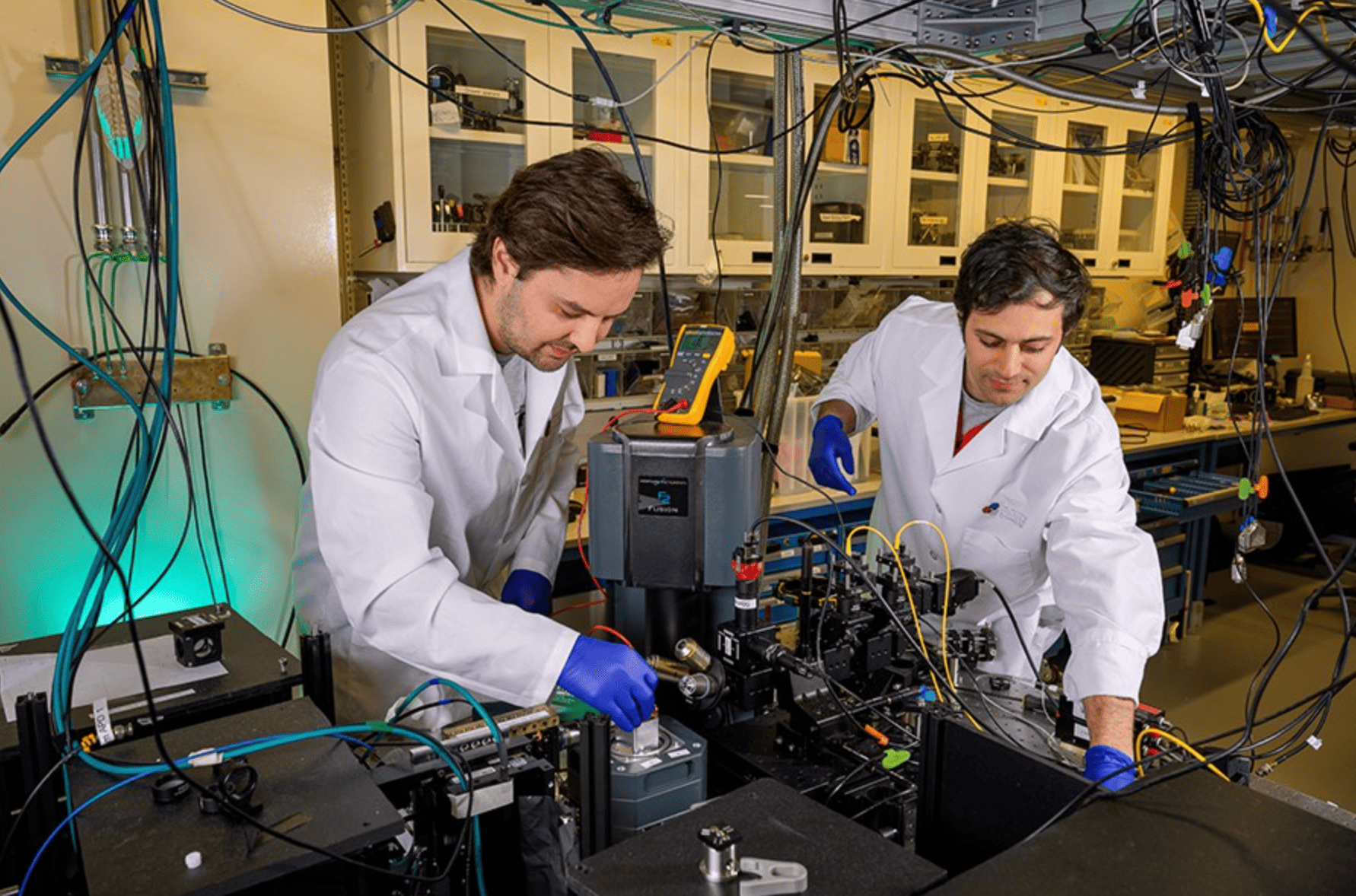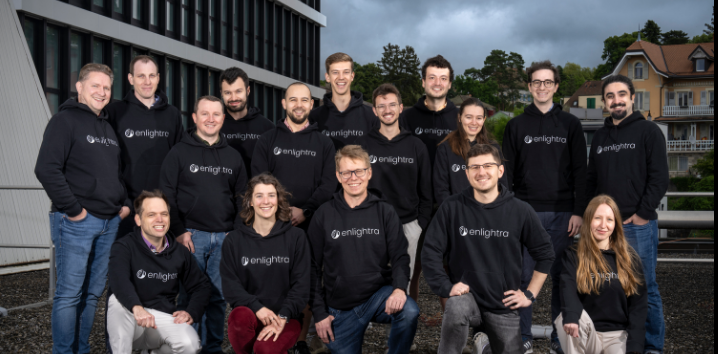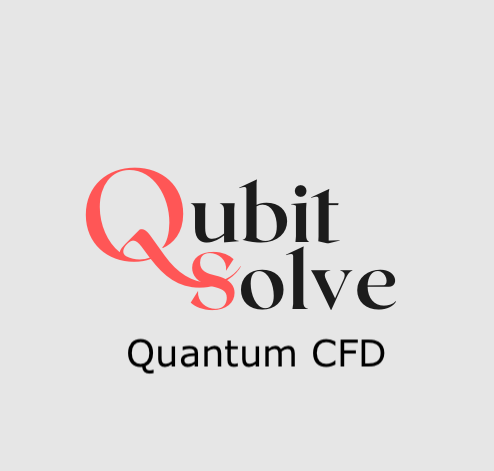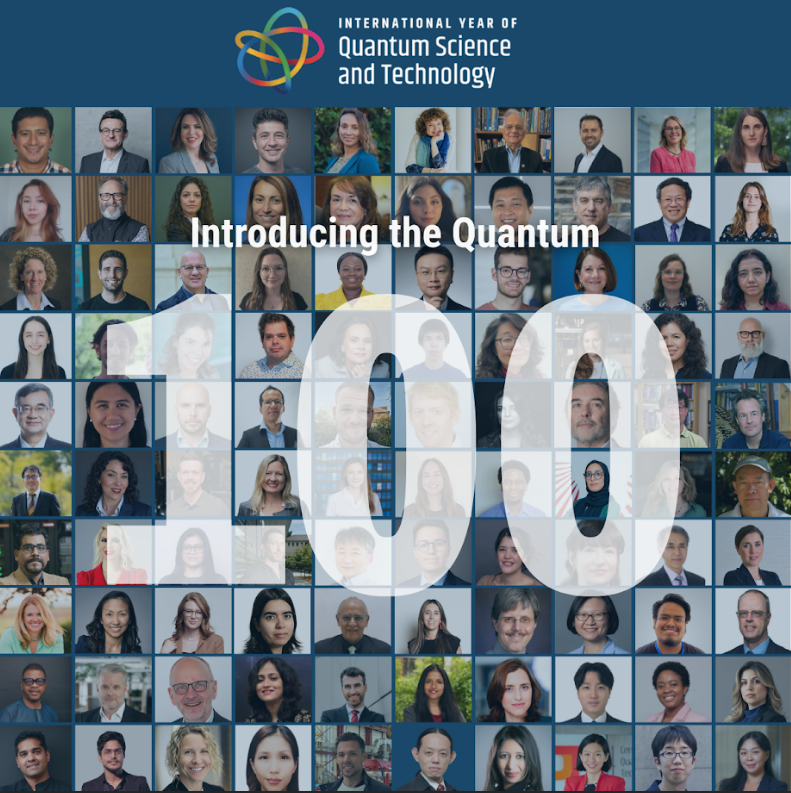Insider Brief
- Researchers at the University of Chicago have shown that enhanced yellow fluorescent protein (EYFP) can act as a quantum bit, functioning in purified samples as well as inside mammalian and bacterial cells.
- The protein qubit demonstrated measurable spin coherence times and optically detected magnetic resonance, confirming that quantum behavior carried over into living systems.
- While less sensitive than diamond-based sensors, the approach introduces a genetically encodable quantum platform with potential applications in nanoscale biological sensing and quantum imaging
- Image: UChicago Pritzker School of Molecular Engineering alum Jacob Feder, PhD’25, and PhD candidate Benjamin Soloway. (UChicago Pritzker School of Molecular Engineering / Jason Smith)
Scientists have turned a fluorescent protein into a working quantum bit, a result that could reshape both quantum computing and quantum biology.
The researchers at the University of Chicago Pritzker School of Molecular Engineering (UChicago PME), who published their study in Nature, demonstrated that enhanced yellow fluorescent protein (EYFP) can function as an optically addressable spin qubit, capable of being initialized, manipulated with microwaves and read out with light. The team demonstrated the effect not only in purified proteins but also inside mammalian and bacterial cells, suggesting a direct path to genetically encodable quantum sensors.
According to the a release from the university, this could open up new investigations into creating quantum biosensors.

“Rather than taking a conventional quantum sensor and trying to camouflage it to enter a biological system, we wanted to explore the idea of using a biological system itself and developing it into a qubit,” said David Awschalom, co-principal investigator of the project, Liew Family Professor of Molecular Engineering at UChicago PME and director of the Chicago Quantum Exchange (CQE). “Harnessing nature to create powerful families of quantum sensors—that’s the new direction here.”
Proteins as Qubits
Qubits, unlike classical bits, can hold superpositions of states, making them the foundation of quantum technologies. Most qubit platforms rely on solid-state materials such as superconducting circuits or diamond defects. The new study reports that proteins widely used in biology as fluorescent tags can also serve as qubits.
The researchers showed that EYFP has a metastable “triplet state” whose spin properties can be controlled. Think of this as a temporary holding pattern where energy lingers long enough for researchers to tap into the electron’s magnetic spin and treat it as a qubit. By applying laser pulses, the scientists achieved triggered readout with up to 20% spin contrast at cryogenic temperatures, according to the study. Microwave fields enabled coherent manipulation, and spin coherence times stretched to about 16 microseconds under dynamical decoupling, comparable to other molecular qubit systems.
While it’s commonly thought that qubits cannot operate in warm environments, the researchers gathered evidence that the protein qubit functioned inside cells. In human kidney cells at low temperature and E. coli at room temperature, the team detected optically driven magnetic resonance signals, proving that the qubit could withstand the messy, noisy environment of living systems.
The advance opens a bridge between quantum information science and the life sciences. Fluorescent proteins have long been staples of microscopy, used to tag and track molecules in living cells. By showing that the same proteins can act as qubits, the work raises the prospect of genetically encoding quantum sensors into organisms.
Some of the possibilities of these sensors — if the findings are validated and it can scale — include sensors that detect magnetic fields, electric fields, or temperature fluctuations at the nanoscale. In medicine, they might be used to probe protein conformations, track biochemical reactions, or monitor how drugs bind to targets with unprecedented precision. In quantum technology, they offer a new testbed for designing and engineering molecular-scale qubits that are directly linked to biology.
“Our findings not only enable new ways for quantum sensing inside living systems but also introduce a radically different approach to designing quantum materials,” Peter Maurer, co-principal investigator and assistant professor of molecular engineering at UChicago PME, said in the release. “Specifically, we can now start using nature’s own tools of evolution and self-assembly to overcome some of the roadblocks faced by current spin-based quantum technology.”
How They Did It
The team built a custom confocal microscope — a laser-based 3D microscope that can get sharp images of tiny objects — to probe the spin states of EYFP molecules. According to the paper, the team used a clever light trick to make the protein’s pause state shorter and easier to measure. By firing a faint infrared laser, they nudged the protein so it released its stored energy in a controlled flash, and that flash carried information about the electron’s spin.
The team used microwaves to flip the protein’s spins in a steady rhythm, creating telltale patterns that confirmed the protein was behaving like a true quantum system.
In cells, EYFP expression was achieved through genetic engineering, just as in standard biological imaging experiments. The observed spin signals matched those of purified proteins, showing that the quantum behavior carried over into the cellular environment.
This was by no means a simple set-up. Awschalom and Maurer both credited he students curiosity and tenacity for the success of the project.
“Research projects often take multiple years, and the outcomes are far from certain. This project was no exception,” said Jacob Feder, a co-first author on the paper and former student of Awschalom and Maurer. Feder received his PhD in April. “This work was only possible because our students had the courage to take risks and push forward even when the results looked discouraging for quite some time,” Awschalom said. “Their persistence is what made this discovery successful—this was a challenging project.”
Still Work to Do
Despite the breakthrough, the platform isn’t quite ready for prime time as it lags behind established solid-state sensors such as nitrogen-vacancy centers in diamond. The measured sensitivities — on the order of microtesla at cryogenic temperatures and millitesla at room temperature — fall short of the best diamond-based systems. Coherence times, though measurable, are modest compared with top solid-state qubits.
Photobleaching of fluorescent proteins also remains a major challenge, limiting their stability under repeated excitation. Improving photostability, spin readout efficiency, and coherence times will be essential before such protein qubits can compete with other quantum platforms.
Future Directions
The authors suggest several ways forward. Substituting nearby hydrogen atoms with deuterium could extend coherence times. Advanced optical readout schemes might boost signal collection by orders of magnitude. Engineering fluorescent proteins through directed evolution—a standard bioengineering technique—could tailor their spin and optical properties for quantum performance.
If sensitivities can be enhanced, protein qubits might enable electron or nuclear magnetic resonance experiments inside cells, providing molecular-level views of biological processes. They could also form the basis for multiplexed quantum imaging, exploiting differences in resonance frequencies to create new “colors” of contrast beyond standard fluorescence.
The work underscores a broader theme: tools of quantum science are beginning to merge with molecular biology. Genetically encodable qubits could create a new class of hybrid technologies, where quantum mechanics is not only a resource for computing and sensing but also a window into the workings of life.
It also points toward a future for quantum biology — and that will require multidisciplinary teams.
“A project like this that is at the convergence of quantum engineering and molecular biology required an interdisciplinary approach that was only possible at a place like UChicago PME,” Maurer said.
Co-first author Benjamin Soloway, a UChicago PME quantum PhD candidate in Awschalom’s lab added in the release: “We’re entering an era where the boundary between quantum physics and biology begins to dissolve. That’s where the really transformative science will happen.”


















